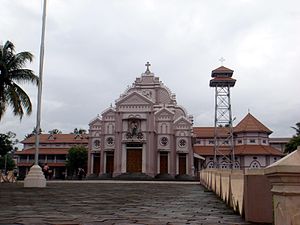Syro-Malabar Catholic Diocese of Irinjalakuda
| Syro-Malabar Catholic Eparchy of Irinjalkuda | |
|---|---|
 |
|
| Location | |
| Country | India |
| Territory | Thrissur district |
| Ecclesiastical province | Kerala |
| Metropolitan | Irinjalakuda |
| Information | |
| Denomination | Syro-Malabar Catholic Church |
| Rite | East Syrian Rite |
| Established | 1978 |
| Cathedral | St Thomas Cathedral & Bishop House |
| Current leadership | |
| Pope | Francis |
| Bishop | Mar Pauly Kannookadan, Bishop of Irinjalakuda |
| Website | |
| irinjalakudadiocese.com | |
The Syro-Malabar Catholic Eparchy of Irinjalakuda is situated in Irinjalakuda city of Thrissur District of Kerala, India. The eparchy was created by Pope Paul VI in his bull Trichurensis Eparchiae of June 22, 1978. Mar James Pazhayattil was the first bishop. He was succeeded by Mar Pauly Kannookadan. The eparchy is a suffragan of the Syro-Malabar Catholic Archeparchy of Thrissur.
St Thomas, one of the apostles of Christ, after receiving the Holy Spirit at Pentecost, set about the mission of spreading the gospel of Jesus Christ to the whole world. A review of the life of St Thomas will prove how he fulfilled this great mission in India. According to the tradition, St Thomas came by sea and landed at Kodungalloor (Cranganore) the capital of the then Chera Empire in 52 AD. He baptised families in Kodungalloor and Palayur (Trichur). St Thomas preached the gospel wherever he went, and founded churches. According to Malabar tradition St Thomas founded seven churches, they are in Cranganore, Quilon, Chayal, Kokkamangalam, Niranam, Paravur and Palayur. From there he went to Coromandel and suffered martyrdom near the Little Mount in Tamil Nadu. His body was brought to the town of Mylapore and was buried in a holy shrine. According to "Ramban Songs", St Thomas converted 17,550 people. He ordained priests and consecrated bishops. The Apostle consecrated Kepa, a native, as Bishop of Kodungalloor and as the head of St Thomas Christians and Paul as the Bishop of Mylapore. It is worth mentioning that the Apostle gave his followers a way of worship suited to their clime, culture and customs. Since the 4th century, the Church in India started communication with the East Syrian Church and soon began to introduce liturgical books and share rites. Thus the Indian Church became a member of the Babylonian(also known as Assyrian &Syro-Chaldean) Patriarchate for practical purpose, not for doctrinal reasons.
...
Wikipedia
